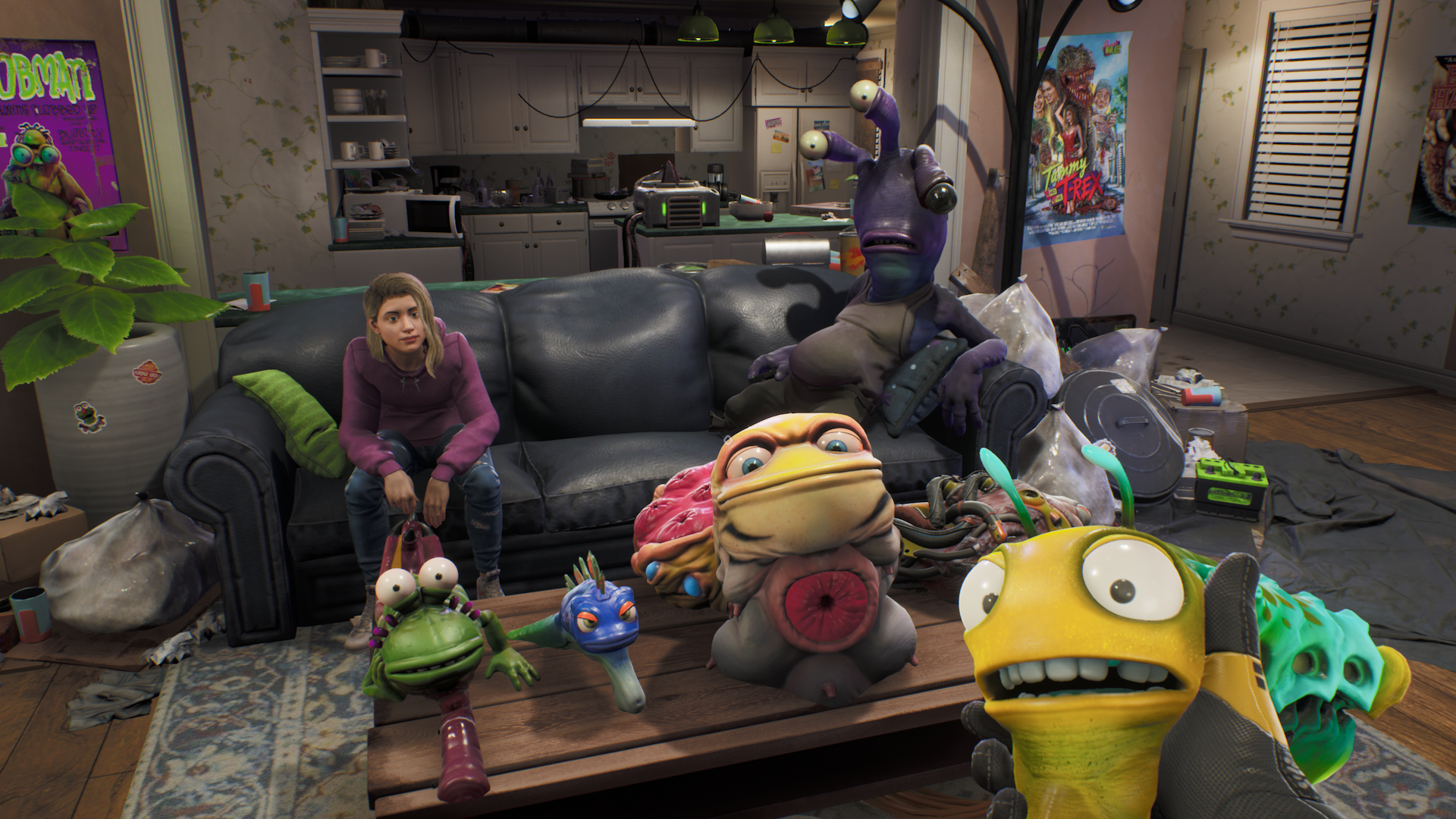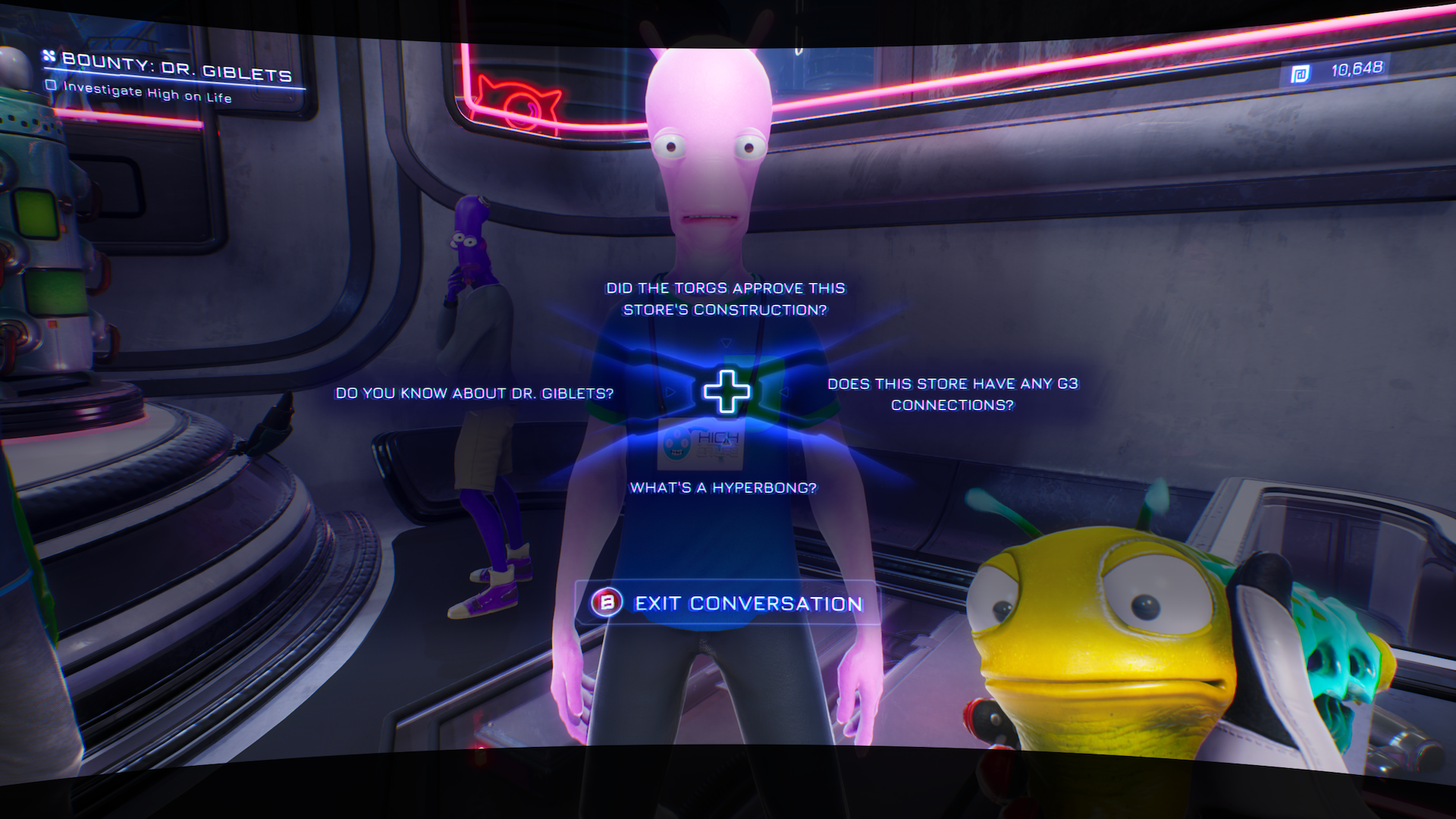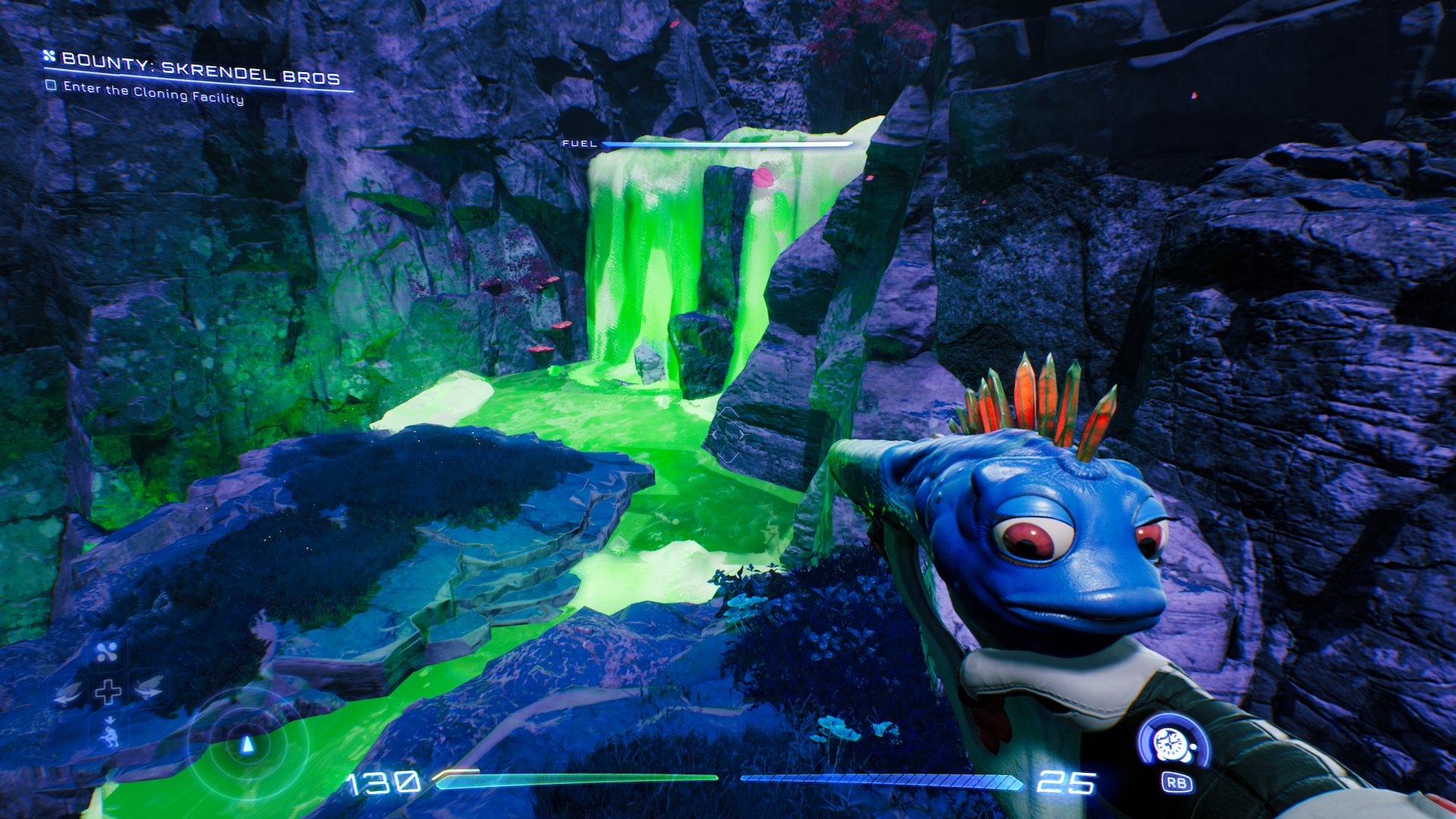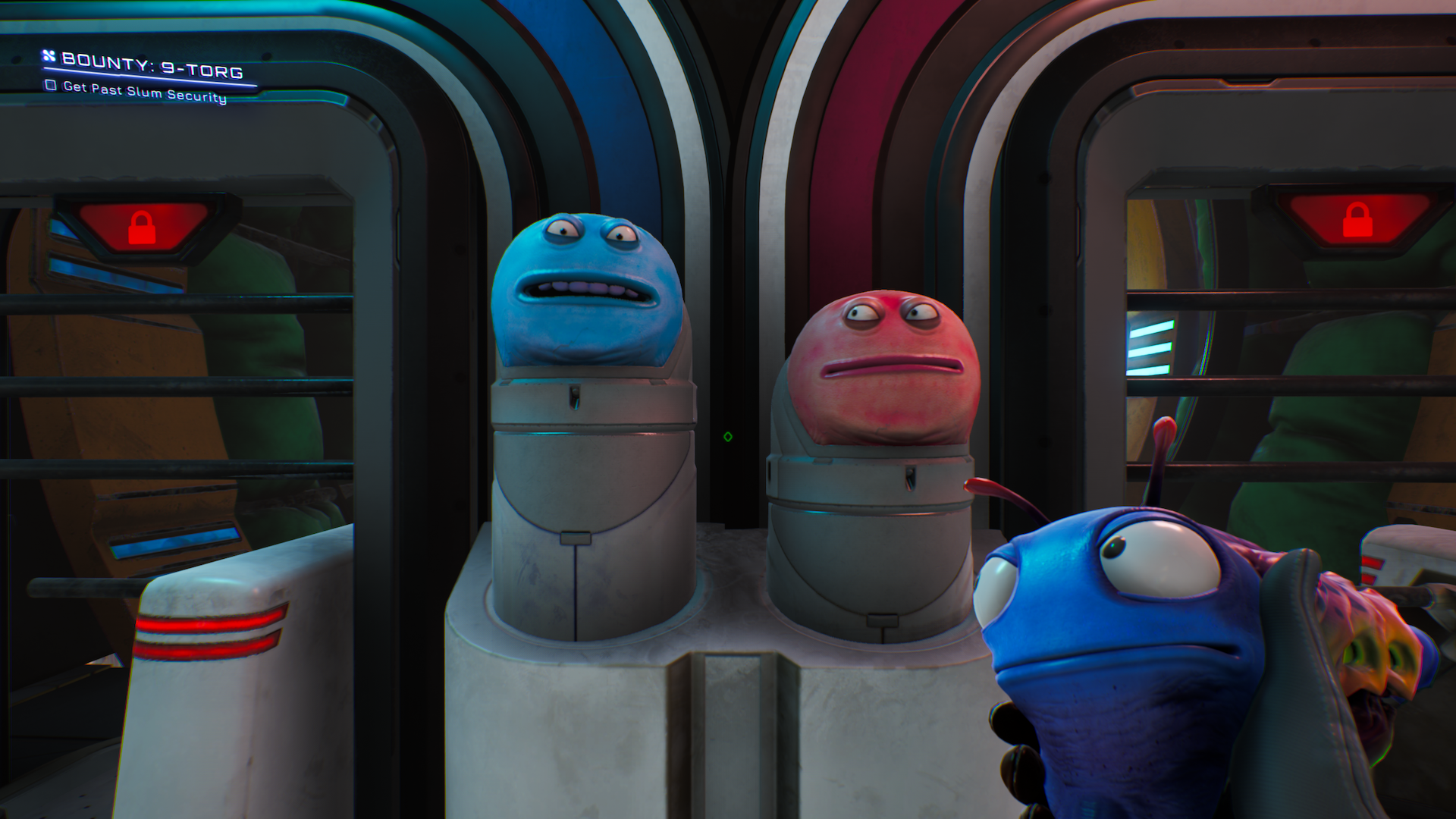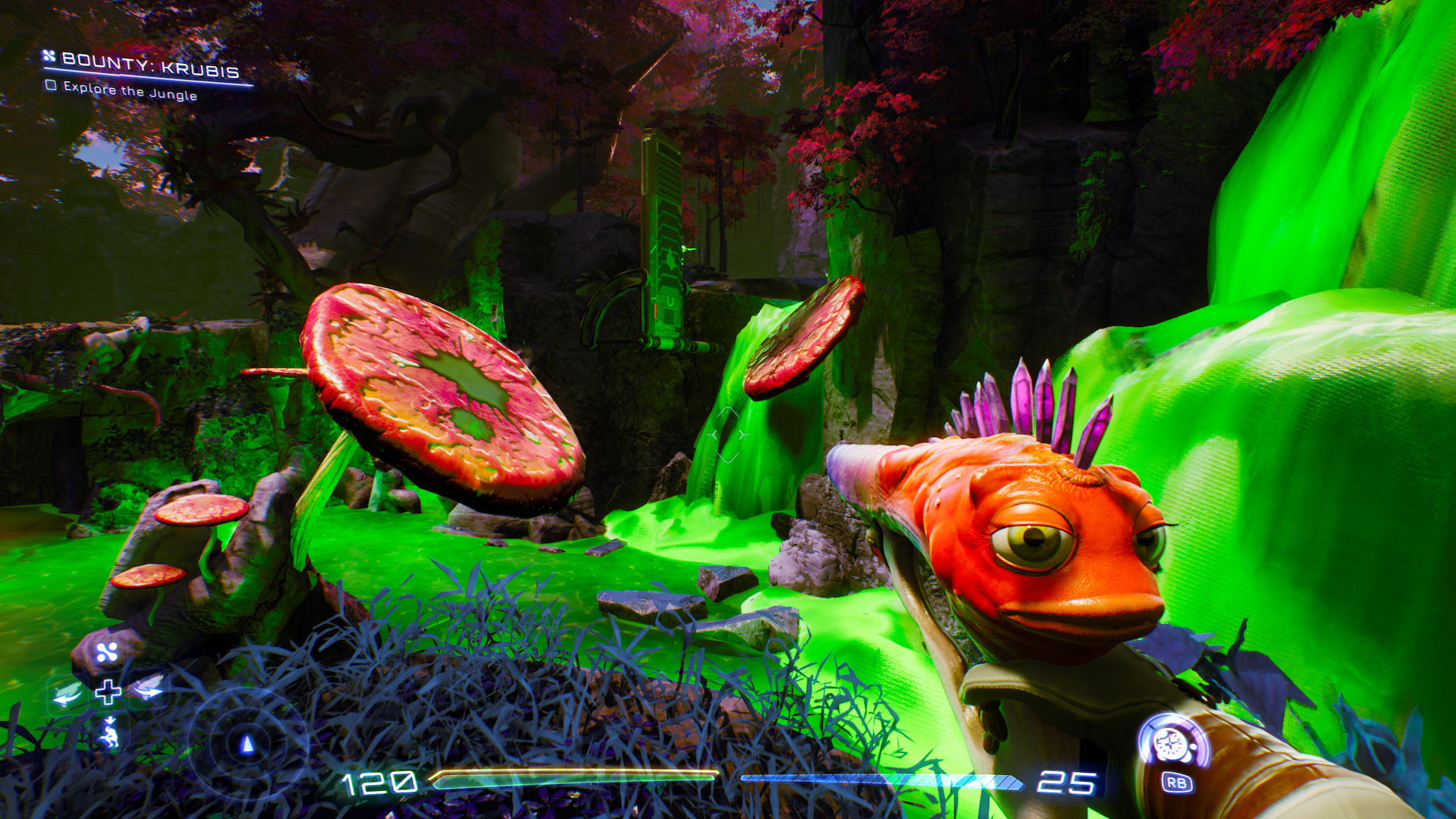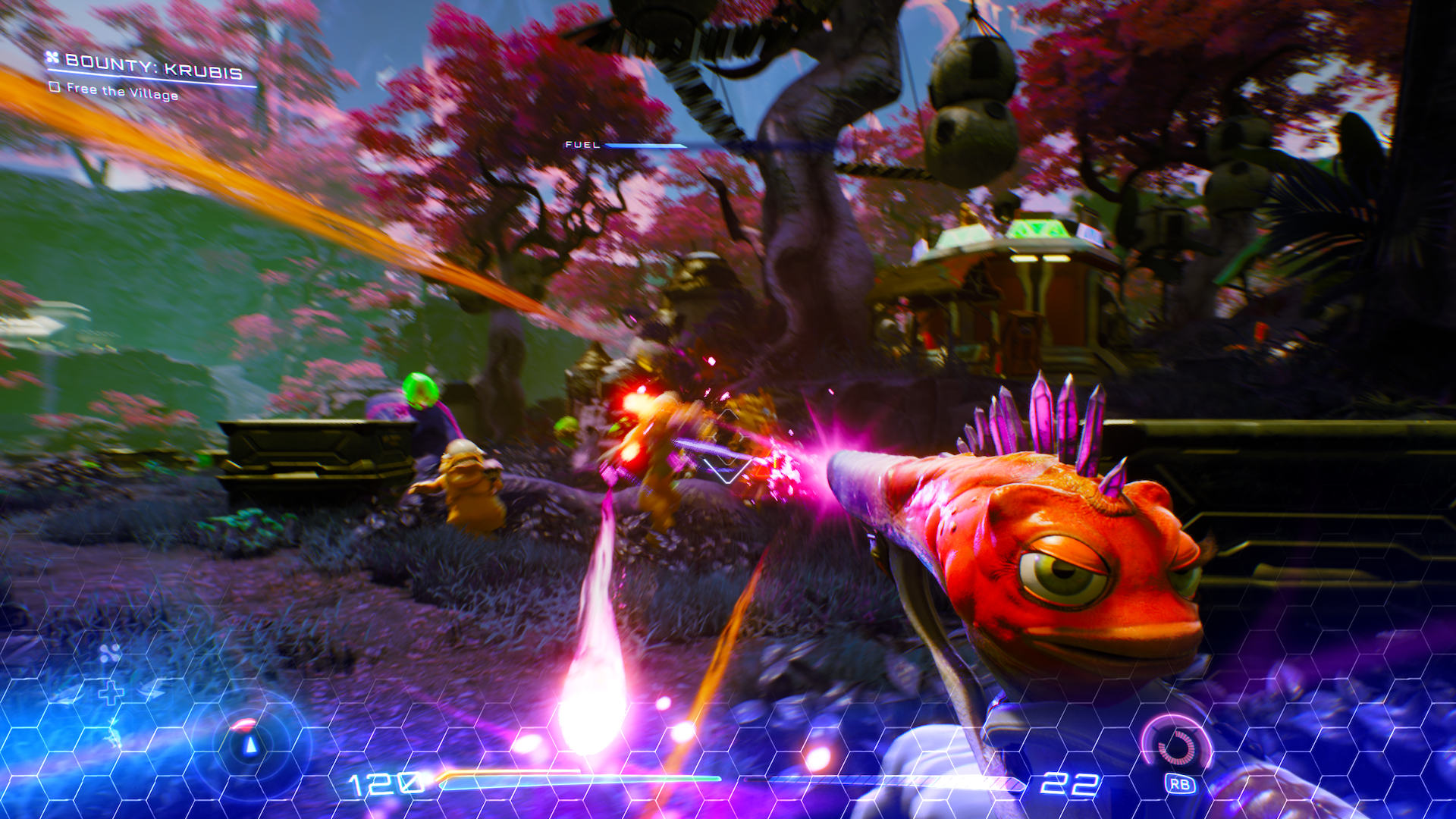You insist on specifics - fine. This is a first-person platformer-shooter in which you play a burbanite kid turned bounty hunter, chasing down alien gangsters who have discovered that they can smoke human beings like pot. There’s a hub city with dimensional gateways to a handful of jungle or desert worlds, built around looping main paths with pop-up “kill till the music stops” enemy waves and the odd hidden collectible. Your guns are moderately upgradeable, Oddworld-style creatures who can speak, or at least swear. Each gun has its own voice actor, and there’s a certain intrigue to hearing how each reacts to the same situation: primary handcannon Kenny, voiced by Squanch Games founder and Rick and Morty creator Justin Roiland, is basically Morty without the anxiety complex. They also shout in combat to let you know that altfire cooldowns have elapsed, and remind you of your objectives. But mostly, they spend the game telling you in various ways why the game sucks, as if this needed any elaboration. The enemies are a watery mix of melee, midrange, sniper and midboss flavours; as Kenny frequently observes, they’re barely worth killing. The platforming sections are tolerable mostly thanks to the game’s generosity about respawning you on ledges when you tumble into acid lakes or bottomless pits. The satirical humour engulfing it all is an exercise in picking at taboos, ranging from casual gags about suicide to a knife called Knifey that loves knifing people (you know, in a sexual way). Everything is couched in the same spirit of evasive, poisoned irony: NPCs who tell you that they’re just here to deliver quest information, and a detective mode section which makes the case that detective mode sections are boring. At the level of running and gunning, at least, it’s not all bad news. There’s a crunchy spread of platforming abilities, unlocked as you find new guns - a grappling hook and jetpack, embeddable razor discs you can stand on, and time bubbles to slow down whirling airduct fans for safe passage. It all adds up to some moderately diverting gated exploration, not that the game’s tiddly planetoids have secrets to spare. Some of the guns are fun to use, too, even if they’re ripped wholesale from the arsenals of better games. There’s a Seth Rogen-esque Pikmin launcher whose eyeless children latch onto enemies and temporarily flip their allegiance. Every now and then, the game feels like a relatively innocent sandbox shooter in the Halo or Far Cry tradition, defined by verticality and the creative chaining of alt-fires, while exploiting terrain elements like pop-out fans, ziplines or breakable cages of omni-hostile fauna. But it’s rickety and forgettable on the whole, with enemies who sometimes space out or get stuck in the geometry, forcing you to search for them to initiate the next story phase. And every time High on Life catches you looking on the bright side, it takes a minute to sabotage itself with a sneering joke. I have never played a game that is quite as committed to pointing out and revelling in its own lack of value. This likely won’t surprise anybody who’s watched Rick and Morty - a show of maniac referentiality and self-loathing, in which a genius narcissist and his grandson go on bloody adventures through scenarios torn from sci-fantasy canon. I’ll admit to a guilty fondness for Rick and Morty, largely because it throws the bloat of even relatively lean sci-fi videogames like The Callisto Protocol into sharp relief. At its best, the show blends the simple dramatic rules of Looney Tunes with a speed of allusion borne of the exhaustive and exhausting variety of social media feeds. It has a hectic appetite for turning the tables on well-worn genre setups, enabled by the fourth wall breaks of a mad scientist who always finds a way to “deus ex machina this shit”. There are lessons for videogame world-builders and mythmakers in how Rick and Morty establishes, plays out and knocks down a premise in moments - take the Mr Meeseeks episode, which makes me think of Philip K. Dick’s tactic of changing something small and letting the world mutate around it. But with that pace comes terminally-online burnout and a performance of despair that borders on earnest, yet too often settles into edgelord cynicism and the same tedious, punchdown humour as South Park. It’s on this side of Rick and Morty that High on Life draws most frequently. It’s the ostentatiously phoned-in mid-season episode full of gags about jacking off, quest-givers who piss themselves, and cute critters who either end up in the mincer or reveal themselves to be total arseholes. The problem is partly that the game beneath the toxic meta-comedy isn’t worth celebrating, and partly that Rick and Morty’s dramatic tenets don’t quite function when you wrap them around a bog-standard shooter campaign. Again, the show is all about speed. Put a player in charge and you create downtime and reversals - backtracking to areas with a new platforming ability, walking to a waypoint rather than conjuring a portal or jump-cutting. Rick and Morty’s bustling 22-minute arcs rely on Rick’s ability to essentially edit out anything stale - unless Rick being bored is the joke, of course. High on Life is 10-to-15 hours of things he’d do away with, which is why it hates itself so much. The game addresses this not just by cracking wise about repetitive content a la Borderlands, but by actively engineering delays to wind you up - setpieces like that detective mode sketch, and improv caricatures who witter on obnoxiously. If there’s anything genuinely amusing about High on Life, it’s seeing this desire to mess you around clash with the need to be readable and coherent. On the one hand, there are skits about the UI being overtaken by spam, and a section where an unkillable flying head blocks your reticule, screeching about its mommy issues. On the other, there are straightforward tutorial windows and HUD tips, suggestive of a QA team sneaking in after hours to amend the design doc, and for all the ostensible nihilism, your guns also tell you off for trying to shoot down story characters. There’s a certain amount of creative promise at work in the scenarios and levels - hints of the same experimental, genre-agnostic ethos you see in many 90s first-person games. Between missions you get to settle arguments between your bratty sister and an alien squatter - a thin splash of Mass Effect sitcom dynamics - and watch live-action B-movies on your lounge TV: the kind of multimedia flourish I haven’t seen since The Darkness. It’s thanks to High on Life that I know of Denise Richards hamfest Tammy and the T-Rex, for what that’s worth. It’s also thanks to High on Life that I’ve seen the inside of a (Space) Applebees, where you’ll click through a confession scene while ordering dip. Sometimes, revisiting areas is worth it for more than just trinkets. During one mission, you teleport in a giant, random chunk of city mainstreet to bridge a chasm. On your return, all the marooned drivers have converted their traffic jam into a weird little village. I’d have liked more of that kind of thing, where the writing briskly unfolds some fun implications, and fewer weakly “provocative” jokes about killing kids. Aside from a botched attempt to rebottle Rick and Morty as a first-person shooter, High on Life is a covert playable manifesto for games in general as callous, explicit and made up of false choices - incubation vats, in short, for cavalier dickheads. If it took itself seriously enough to make statements, it might offer itself as an expression of the artform at its worst. It doesn’t want to be finished though, really. Much like the bisected teddybear you find bleeding out in one particular canyon, High on Life just wants to be put out of its misery.

